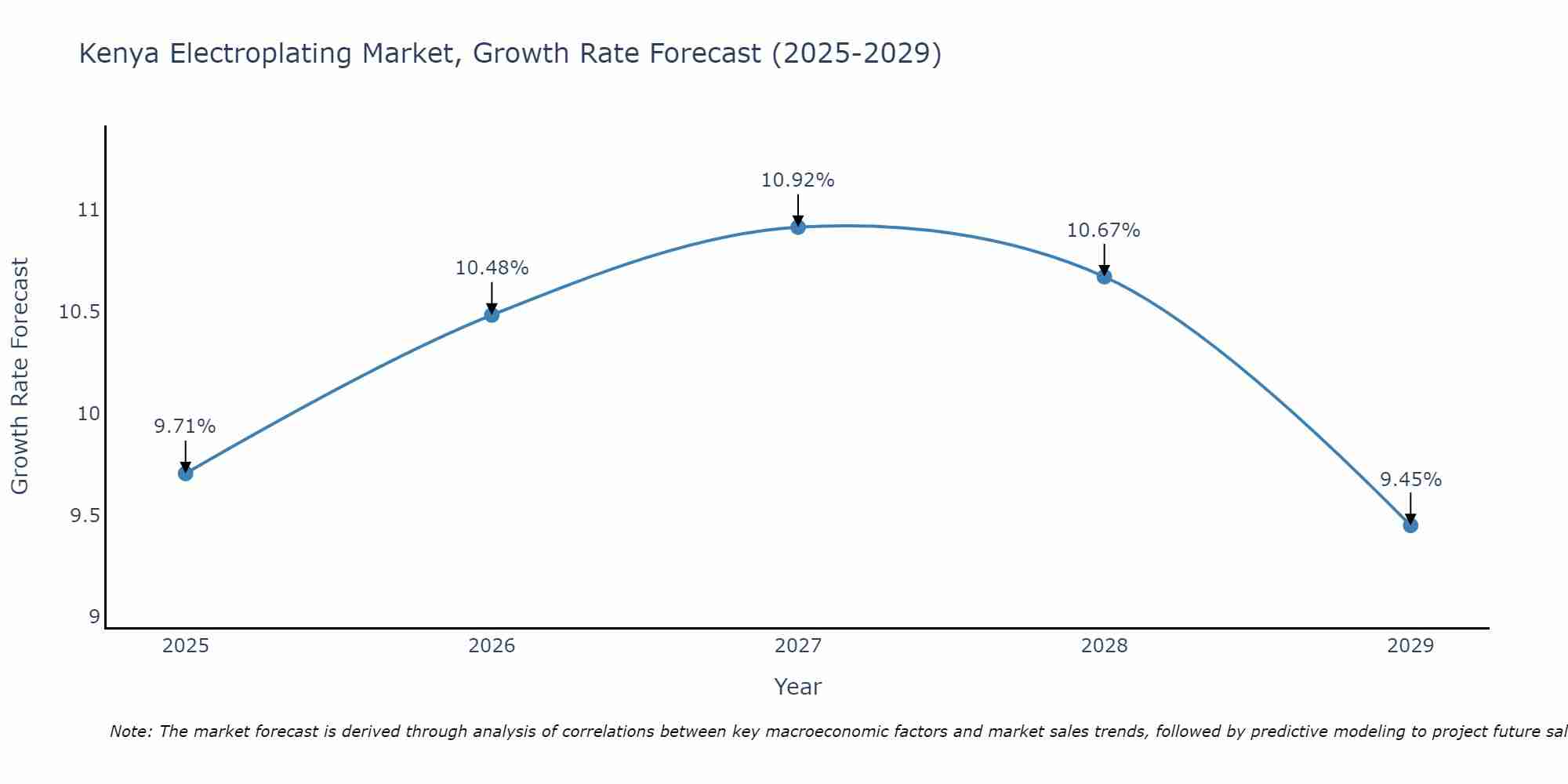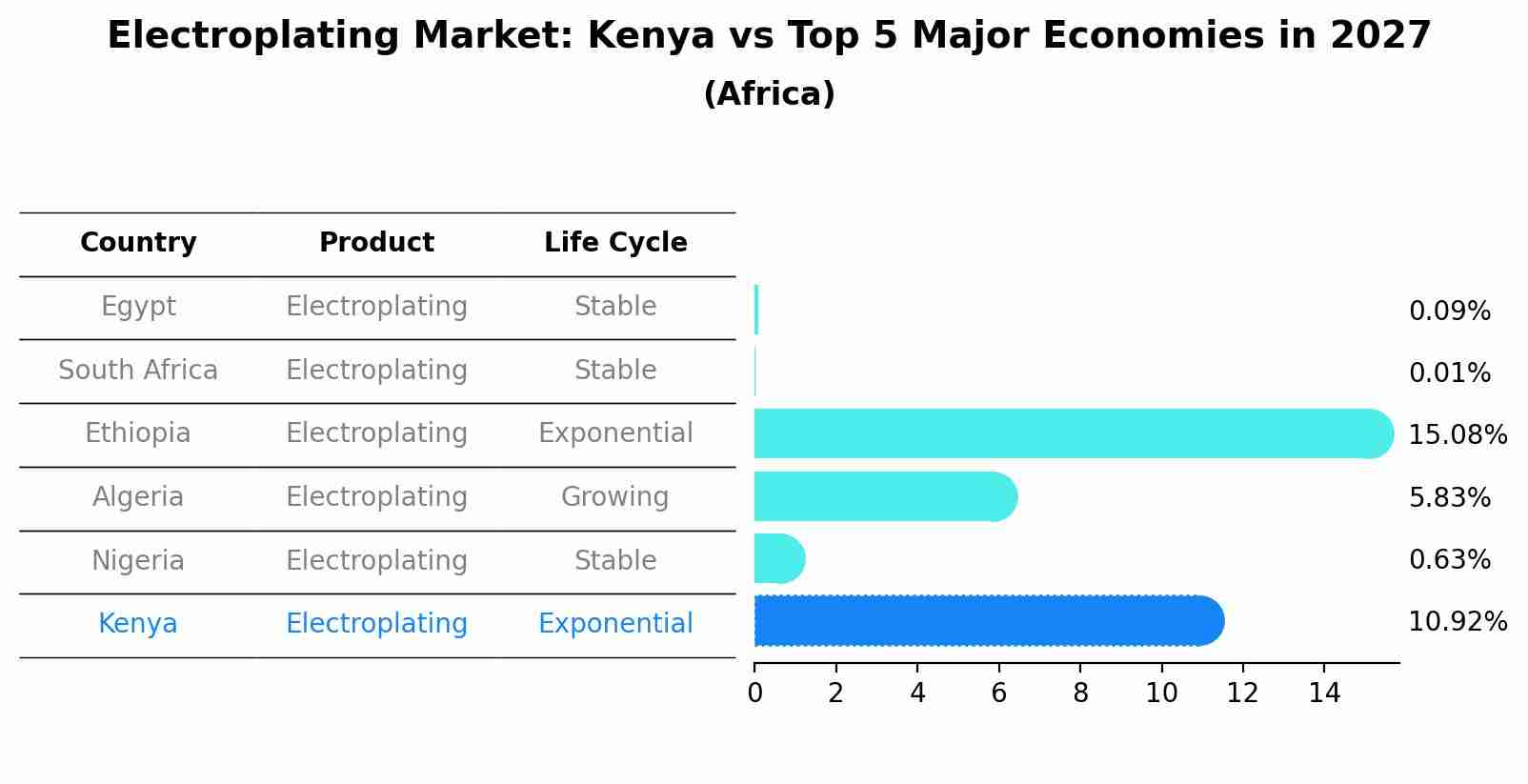Kenya Electroplating Market Outlook | Companies, Forecast, COVID-19 IMPACT, Growth, Size, Analysis, Share, Industry, Trends, Revenue & Value
| Product Code: ETC104649 | Publication Date: Jun 2021 | Updated Date: Jun 2025 | Product Type: Report | |
| Publisher: 6Wresearch | Author: Dhaval Chaurasia | No. of Pages: 70 | No. of Figures: 35 | No. of Tables: 5 |
Kenya Electroplating Market Size Growth Rate
The Kenya Electroplating Market is projected to witness mixed growth rate patterns during 2025 to 2029. The growth rate begins at 9.71% in 2025, climbs to a high of 10.92% in 2027, and moderates to 9.45% by 2029.

Electroplating Market: Kenya vs Top 5 Major Economies in 2027 (Africa)
The Electroplating market in Kenya is projected to grow at a high growth rate of 10.92% by 2027, highlighting the country's increasing focus on advanced technologies within the Africa region, where Egypt holds the dominant position, followed closely by South Africa, Ethiopia, Algeria and Nigeria, shaping overall regional demand.

Kenya Electroplating Market Overview
The Kenya Electroplating Market is experiencing steady growth driven by increased industrial activities across sectors such as automotive, electronics, and construction. The market is witnessing a rise in demand for electroplating services to enhance the durability, corrosion resistance, and aesthetic appeal of various metal components. Key players in the market are focusing on technological advancements to offer eco-friendly and cost-effective solutions, attracting a broader customer base. The market is also benefiting from government initiatives to boost manufacturing and industrial capabilities in the country. However, challenges such as environmental regulations and fluctuating raw material prices pose constraints to market growth. Overall, the Kenya Electroplating Market presents opportunities for expansion and innovation, with a growing emphasis on sustainable practices and quality standards.
Kenya Electroplating Market Trends
The Kenya Electroplating Market is experiencing significant growth driven by increasing demand from industries such as automotive, electronics, and aerospace. There is a growing emphasis on eco-friendly and sustainable electroplating processes to comply with environmental regulations. Companies in the market are investing in advanced technologies to improve efficiency, reduce waste, and enhance the quality of plated products. Additionally, there is a rising trend towards customization and decorative electroplating services to cater to the needs of various end-user industries. The market is also witnessing an increased adoption of automation and robotics in electroplating processes to streamline operations and improve productivity. Overall, the Kenya Electroplating Market is poised for steady growth with a focus on innovation, sustainability, and technological advancements.
Kenya Electroplating Market Challenges
The Kenya Electroplating Market faces several challenges, including environmental regulations regarding the disposal of hazardous chemicals used in the electroplating process. Compliance with these regulations is a significant challenge for businesses operating in the market, as non-compliance can lead to fines and damage to the company`s reputation. Additionally, the market also struggles with the availability of skilled labor and the high cost of importing raw materials and equipment needed for electroplating operations. Economic instability and fluctuating exchange rates further complicate the business environment for electroplating companies in Kenya, making it challenging to forecast costs and plan for future growth effectively. Overall, navigating these challenges requires proactive strategies and a commitment to sustainability and compliance for businesses in the Kenya Electroplating Market.
Kenya Electroplating Market Investment Opportunities
The Kenya Electroplating Market presents promising investment opportunities due to the country`s growing manufacturing sector and increasing demand for electroplated products across various industries such as automotive, electronics, and construction. Investors can consider setting up or expanding electroplating facilities to cater to the rising local demand for high-quality surface finishing solutions. Additionally, adopting environmentally friendly electroplating technologies can help attract sustainability-conscious customers and comply with regulations. Collaboration with local manufacturers and offering specialized services such as corrosion-resistant coatings or decorative finishes can also differentiate businesses in the competitive market. Overall, the Kenya Electroplating Market offers potential for growth and profitability for investors willing to leverage the country`s industrial development and demand for electroplated products.
Kenya Electroplating Market Government Policy
In Kenya, the government has implemented various policies to regulate the electroplating market. The National Environment Management Authority (NEMA) oversees environmental regulations to ensure that electroplating facilities adhere to standards that minimize pollution and protect natural resources. Additionally, the government has set up licensing requirements and inspections to monitor the operations of electroplating businesses and ensure compliance with health and safety regulations. The Ministry of Industrialization, Trade, and Enterprise Development also plays a role in promoting the growth of the electroplating industry through incentives and support programs for local businesses. Overall, the government`s policies aim to balance the growth of the electroplating market with environmental sustainability and public health considerations.
Kenya Electroplating Market Future Outlook
The Kenya Electroplating Market is poised for steady growth in the coming years driven by increasing demand from industries such as automotive, electronics, and aerospace. The market is expected to benefit from the country`s growing manufacturing sector and the government`s focus on industrial development. Additionally, rising consumer awareness regarding the importance of quality surface finishing for products is likely to drive the demand for electroplating services. However, challenges such as fluctuating raw material prices and environmental regulations may impact market growth. To stay competitive, key players in the Kenya Electroplating Market are expected to invest in technology upgrades, sustainable practices, and capacity expansion to meet the evolving needs of customers and adhere to stringent quality standards.
Key Highlights of the Report:
- Kenya Electroplating Market Outlook
- Market Size of Kenya Electroplating Market, 2021
- Forecast of Kenya Electroplating Market, 2027
- Historical Data and Forecast of Kenya Electroplating Revenues & Volume for the Period 2018 - 2027
- Kenya Electroplating Market Trend Evolution
- Kenya Electroplating Market Drivers and Challenges
- Kenya Electroplating Price Trends
- Kenya Electroplating Porter's Five Forces
- Kenya Electroplating Industry Life Cycle
- Historical Data and Forecast of Kenya Electroplating Market Revenues & Volume By Metal for the Period 2018 - 2027
- Historical Data and Forecast of Kenya Electroplating Market Revenues & Volume By Gold for the Period 2018 - 2027
- Historical Data and Forecast of Kenya Electroplating Market Revenues & Volume By Copper for the Period 2018 - 2027
- Historical Data and Forecast of Kenya Electroplating Market Revenues & Volume By Nickel for the Period 2018 - 2027
- Historical Data and Forecast of Kenya Electroplating Market Revenues & Volume By Others for the Period 2018 - 2027
- Historical Data and Forecast of Kenya Electroplating Market Revenues & Volume By Type for the Period 2018 - 2027
- Historical Data and Forecast of Kenya Electroplating Market Revenues & Volume By Barrel Plating for the Period 2018 - 2027
- Historical Data and Forecast of Kenya Electroplating Market Revenues & Volume By Rack Plating for the Period 2018 - 2027
- Historical Data and Forecast of Kenya Electroplating Market Revenues & Volume By Continuous Plating for the Period 2018 - 2027
- Historical Data and Forecast of Kenya Electroplating Market Revenues & Volume By Line Plating for the Period 2018 - 2027
- Historical Data and Forecast of Kenya Electroplating Market Revenues & Volume By End-User Industry for the Period 2018 - 2027
- Historical Data and Forecast of Kenya Electroplating Market Revenues & Volume By Automotive for the Period 2018 - 2027
- Historical Data and Forecast of Kenya Electroplating Market Revenues & Volume By Electrical and Electronics for the Period 2018 - 2027
- Historical Data and Forecast of Kenya Electroplating Market Revenues & Volume By Aerospace and Defense for the Period 2018 - 2027
- Historical Data and Forecast of Kenya Electroplating Market Revenues & Volume By Medical for the Period 2018 - 2027
- Historical Data and Forecast of Kenya Electroplating Market Revenues & Volume By Others for the Period 2018 - 2027
- Kenya Electroplating Import Export Trade Statistics
- Market Opportunity Assessment By Metal
- Market Opportunity Assessment By Type
- Market Opportunity Assessment By End-User Industry
- Kenya Electroplating Top Companies Market Share
- Kenya Electroplating Competitive Benchmarking By Technical and Operational Parameters
- Kenya Electroplating Company Profiles
- Kenya Electroplating Key Strategic Recommendations
Frequently Asked Questions About the Market Study (FAQs):
- Single User License$ 1,995
- Department License$ 2,400
- Site License$ 3,120
- Global License$ 3,795
Search
Thought Leadership and Analyst Meet
Our Clients
Related Reports
- Germany Breakfast Food Market (2026-2032) | Industry, Share, Growth, Size, Companies, Value, Analysis, Revenue, Trends, Forecast & Outlook
- Australia Briquette Market (2025-2031) | Growth, Size, Revenue, Forecast, Analysis, Trends, Value, Share, Industry & Companies
- Vietnam System Integrator Market (2025-2031) | Size, Companies, Analysis, Industry, Value, Forecast, Growth, Trends, Revenue & Share
- ASEAN and Thailand Brain Health Supplements Market (2025-2031) | Strategy, Consumer Insights, Analysis, Investment Trends, Opportunities, Growth, Size, Share, Industry, Revenue, Segments, Value, Segmentation, Supply, Forecast, Restraints, Outlook, Competition, Drivers, Trends, Demand, Pricing Analysis, Competitive, Strategic Insights, Companies, Challenges
- ASEAN Bearings Market (2025-2031) | Strategy, Consumer Insights, Analysis, Investment Trends, Opportunities, Growth, Size, Share, Industry, Revenue, Segments, Value, Segmentation, Supply, Forecast, Restraints, Outlook, Competition, Drivers, Trends, Demand, Pricing Analysis, Competitive, Strategic Insights, Companies, Challenges
- Europe Flooring Market (2025-2031) | Outlook, Share, Industry, Trends, Forecast, Companies, Revenue, Size, Analysis, Growth & Value
- Saudi Arabia Manlift Market (2025-2031) | Outlook, Size, Growth, Trends, Companies, Industry, Revenue, Value, Share, Forecast & Analysis
- Uganda Excavator, Crane, and Wheel Loaders Market (2025-2031) | Strategy, Consumer Insights, Analysis, Investment Trends, Opportunities, Growth, Size, Share, Industry, Revenue, Segments, Value, Segmentation, Supply, Forecast, Restraints, Outlook, Competition, Drivers, Trends, Demand, Pricing Analysis, Competitive, Strategic Insights, Companies, Challenges
- Rwanda Excavator, Crane, and Wheel Loaders Market (2025-2031) | Strategy, Consumer Insights, Analysis, Investment Trends, Opportunities, Growth, Size, Share, Industry, Revenue, Segments, Value, Segmentation, Supply, Forecast, Restraints, Outlook, Competition, Drivers, Trends, Demand, Pricing Analysis, Competitive, Strategic Insights, Companies, Challenges
- Kenya Excavator, Crane, and Wheel Loaders Market (2025-2031) | Strategy, Consumer Insights, Analysis, Investment Trends, Opportunities, Growth, Size, Share, Industry, Revenue, Segments, Value, Segmentation, Supply, Forecast, Restraints, Outlook, Competition, Drivers, Trends, Demand, Pricing Analysis, Competitive, Strategic Insights, Companies, Challenges
Industry Events and Analyst Meet
Whitepaper
- Middle East & Africa Commercial Security Market Click here to view more.
- Middle East & Africa Fire Safety Systems & Equipment Market Click here to view more.
- GCC Drone Market Click here to view more.
- Middle East Lighting Fixture Market Click here to view more.
- GCC Physical & Perimeter Security Market Click here to view more.
6WResearch In News
- Doha a strategic location for EV manufacturing hub: IPA Qatar
- Demand for luxury TVs surging in the GCC, says Samsung
- Empowering Growth: The Thriving Journey of Bangladesh’s Cable Industry
- Demand for luxury TVs surging in the GCC, says Samsung
- Video call with a traditional healer? Once unthinkable, it’s now common in South Africa
- Intelligent Buildings To Smooth GCC’s Path To Net Zero


















